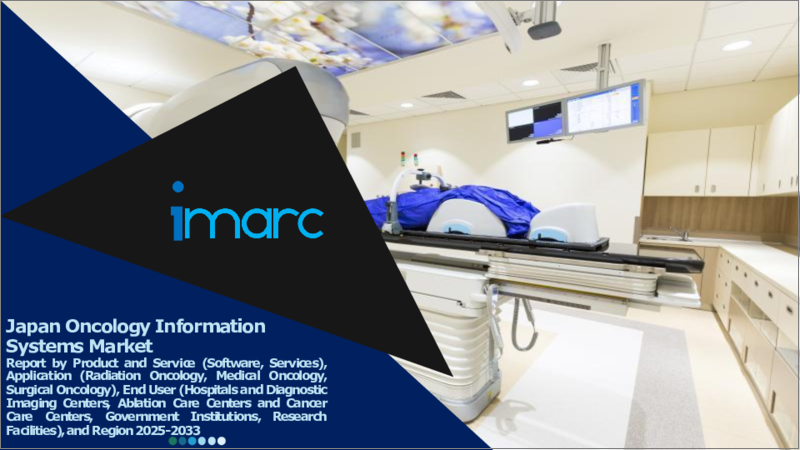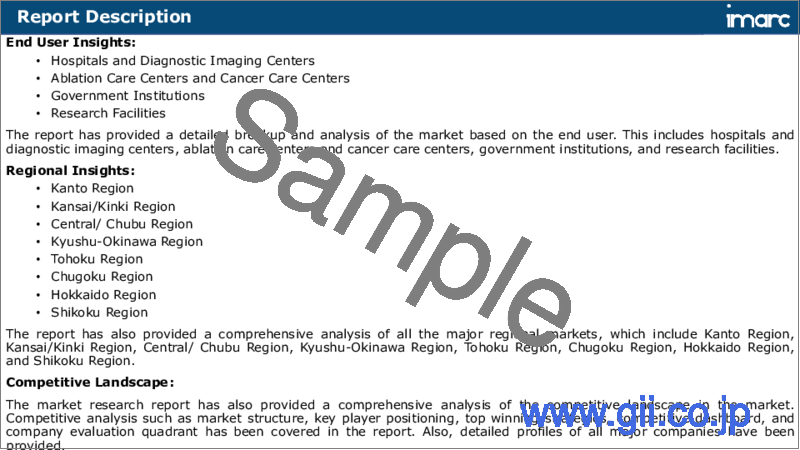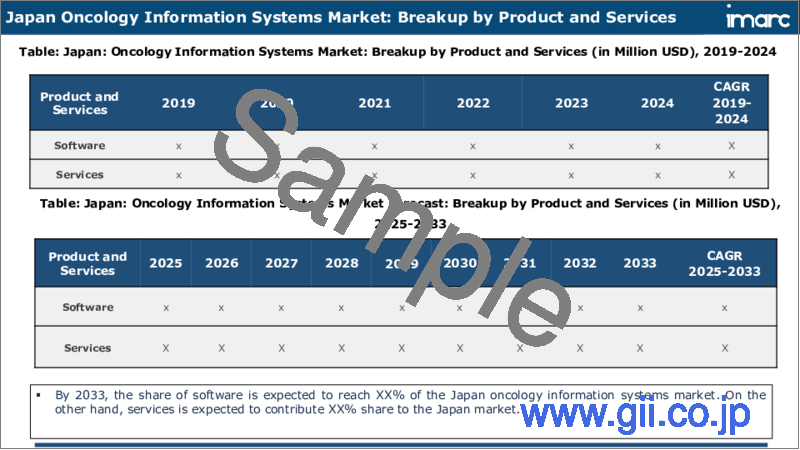|
|
市場調査レポート
商品コード
1609774
日本のオンコロジー情報システム市場レポート:製品・サービス、用途、エンドユーザー、地域別、2025年~2033年Japan Oncology Information Systems Market Report by Product and Service, Application, End User, and Region 2025-2033 |
||||||
カスタマイズ可能
|
|||||||
| 日本のオンコロジー情報システム市場レポート:製品・サービス、用途、エンドユーザー、地域別、2025年~2033年 |
|
出版日: 2024年12月05日
発行: IMARC
ページ情報: 英文 117 Pages
納期: 5~7営業日
|
全表示
- 概要
- 目次
日本のオンコロジー情報システム市場の市場規模は2024年に1億1,910万米ドルに達しました。今後、IMARC Groupは、市場は2033年までに2億4,810万米ドルに達し、2025~2033年の成長率(CAGR)は8.5%になると予測しています。がん罹患率の上昇に加え、患者データ、治療計画、転帰を管理する効率的なシステムに対するニーズの高まりが市場を牽引しています。
本レポートで扱う主な質問
- 日本のオンコロジー情報システム市場はこれまでどのように推移し、今後どのように推移するのか?
- COVID-19の日本のオンコロジー情報システム市場への影響は?
- 日本のオンコロジー情報システム市場の製品・サービス別の内訳は?
- 日本のオンコロジー情報システム市場の用途別の内訳は?
- 日本のオンコロジー情報システム市場のエンドユーザー別の内訳は?
- 日本のオンコロジー情報システム市場のバリューチェーンにはどのような段階がありますか?
- 日本のオンコロジー情報システムにおける主な促進要因と課題は何か?
- 日本のオンコロジー情報システム市場の構造と主要プレーヤーは?
- 日本のオンコロジー情報システム市場における競合の程度は?
目次
第1章 序文
第2章 調査範囲と調査手法
- 調査の目的
- ステークホルダー
- データソース
- 市場推定
- 調査手法
第3章 エグゼクティブサマリー
第4章 日本のオンコロジー情報システム市場:イントロダクション
- 概要
- 市場力学
- 業界動向
- 競合情報
第5章 日本のオンコロジー情報システム市場情勢
- 過去および現在の市場動向(2019年~2024年)
- 市場予測(2025-2033)
第6章 日本のオンコロジー情報システム市場:製品・サービス別の内訳
- ソフトウェア
- サービス
第7章 日本のオンコロジー情報システム市場:用途別の内訳
- 放射線腫瘍学
- 腫瘍内科
- 外科腫瘍学
第8章 日本のオンコロジー情報システム市場:エンドユーザー別の内訳
- 病院および画像診断センター
- アブレーションケアセンターとがんケアセンター
- 政府機関
- 研究施設
第9章 日本のオンコロジー情報システム市場:競合情勢
- 概要
- 市場構造
- 市場プレーヤーのポジショニング
- 主要成功戦略
- 競合ダッシュボード
- 企業評価象限
第10章 主要企業のプロファイル
第11章 日本のオンコロジー情報システム市場:業界分析
- 促進要因・抑制要因・機会
- ポーターのファイブフォース分析
- バリューチェーン分析
第12章 付録
Japan oncology information systems market size reached USD 119.1 Million in 2024. Looking forward, IMARC Group expects the market to reach USD 248.1 Million by 2033, exhibiting a growth rate (CAGR) of 8.5% during 2025-2033. The rising incidence of cancer, coupled with the increasing need for efficient systems to manage patient data, treatment plans, and outcomes, is driving the market.
Oncology information systems (OIS) are specialized software solutions designed to streamline and optimize the management of cancer care within healthcare institutions. These systems play a crucial role in the field of oncology by facilitating the efficient storage, retrieval, and analysis of patient data related to cancer diagnosis and treatment. OIS typically encompasses a range of functionalities, including electronic health records (EHRs) tailored to cancer patients, treatment planning and management tools, scheduling and appointment tracking, and integration with medical imaging and laboratory systems. OIS aims to improve the coordination of care among multidisciplinary oncology teams, ensuring that healthcare professionals have access to up-to-date patient information and treatment plans. They also aid in compliance with regulatory requirements and quality assurance standards in cancer care. By centralizing and digitizing oncology-related data, OIS not only enhances patient care but also supports research efforts by providing valuable data for clinical trials and outcome analysis.
Japan Oncology Information Systems Market Trends:
The oncology information systems market in Japan is multifaceted and interconnected, propelling this sector toward substantial growth. Firstly, the escalating incidence of cancer is a key catalyst. As the prevalence of cancer continues to rise, healthcare providers are seeking more efficient ways to manage patient data and treatment regimens. Consequently, OIS solutions are in high demand to streamline oncology workflows. Moreover, the increasing emphasis on personalized medicine is driving OIS adoption. With advancements in genomics and targeted therapies, oncologists require sophisticated tools to tailor treatments to individual patients. OIS systems enable the seamless integration of patient data, genomic information, and treatment plans, ensuring precise and personalized care. Additionally, regulatory requirements and the need for compliance are influencing OIS adoption. Healthcare organizations must adhere to strict data privacy and security regulations, and OIS solutions provide robust features to meet these requirements. Furthermore, the escalating application of telemedicine and remote monitoring in oncology care to manage remote consultations, monitor patient progress, and share information among healthcare professionals is expected to drive the oncology information systems market in Japan during the forecast period.
Japan Oncology Information Systems Market Segmentation:
Product and Services Insights:
- Software
- Patient Information Systems
- Treatment Planning Systems
- Services
- Consulting Services
- Implementation Services
- Maintenance Services
Application Insights:
- Radiation Oncology
- Medical Oncology
- Surgical Oncology
End User Insights:
- Hospitals and Diagnostic Imaging Centers
- Ablation Care Centers and Cancer Care Centers
- Government Institutions
- Research Facilities
Competitive Landscape:
The market research report has also provided a comprehensive analysis of the competitive landscape in the market. Competitive analysis such as market structure, key player positioning, top winning strategies, competitive dashboard, and company evaluation quadrant has been covered in the report. Also, detailed profiles of all major companies have been provided.
Key Questions Answered in This Report:
- How has the Japan oncology information systems market performed so far and how will it perform in the coming years?
- What has been the impact of COVID-19 on the Japan oncology information systems market?
- What is the breakup of the Japan oncology information systems market on the basis of product and services?
- What is the breakup of the Japan oncology information systems market on the basis of application?
- What is the breakup of the Japan oncology information systems market on the basis of end user?
- What are the various stages in the value chain of the Japan oncology information systems market?
- What are the key driving factors and challenges in the Japan oncology information systems?
- What is the structure of the Japan oncology information systems market and who are the key players?
- What is the degree of competition in the Japan oncology information systems market?
Table of Contents
1 Preface
2 Scope and Methodology
- 2.1 Objectives of the Study
- 2.2 Stakeholders
- 2.3 Data Sources
- 2.3.1 Primary Sources
- 2.3.2 Secondary Sources
- 2.4 Market Estimation
- 2.4.1 Bottom-Up Approach
- 2.4.2 Top-Down Approach
- 2.5 Forecasting Methodology
3 Executive Summary
4 Japan Oncology Information Systems Market - Introduction
- 4.1 Overview
- 4.2 Market Dynamics
- 4.3 Industry Trends
- 4.4 Competitive Intelligence
5 Japan Oncology Information Systems Market Landscape
- 5.1 Historical and Current Market Trends (2019-2024)
- 5.2 Market Forecast (2025-2033)
6 Japan Oncology Information Systems Market - Breakup by Product and Services
- 6.1 Software
- 6.1.1 Overview
- 6.1.2 Historical and Current Market Trends (2019-2024)
- 6.1.3 Market Segmentation
- 6.1.3.1 Patient Information Systems
- 6.1.3.2 Treatment Planning Systems
- 6.1.4 Market Forecast (2025-2033)
- 6.2 Services
- 6.2.1 Overview
- 6.2.2 Historical and Current Market Trends (2019-2024)
- 6.2.3 Market Segmentation
- 6.2.3.1 Consulting Services
- 6.2.3.2 Implementation Services
- 6.2.3.3 Maintenance Services
- 6.2.4 Market Forecast (2025-2033)
7 Japan Oncology Information Systems Market - Breakup by Application
- 7.1 Radiation Oncology
- 7.1.1 Overview
- 7.1.2 Historical and Current Market Trends (2019-2024)
- 7.1.3 Market Forecast (2025-2033)
- 7.2 Medical Oncology
- 7.2.1 Overview
- 7.2.2 Historical and Current Market Trends (2019-2024)
- 7.2.3 Market Forecast (2025-2033)
- 7.3 Surgical Oncology
- 7.3.1 Overview
- 7.3.2 Historical and Current Market Trends (2019-2024)
- 7.3.3 Market Forecast (2025-2033)
8 Japan Oncology Information Systems Market - Breakup by End User
- 8.1 Hospitals and Diagnostic Imaging Centers
- 8.1.1 Overview
- 8.1.2 Historical and Current Market Trends (2019-2024)
- 8.1.3 Market Forecast (2025-2033)
- 8.2 Ablation Care Centers and Cancer Care Centers
- 8.2.1 Overview
- 8.2.2 Historical and Current Market Trends (2019-2024)
- 8.2.3 Market Forecast (2025-2033)
- 8.3 Government Institutions
- 8.3.1 Overview
- 8.3.2 Historical and Current Market Trends (2019-2024)
- 8.3.3 Market Forecast (2025-2033)
- 8.4 Research Facilities
- 8.4.1 Overview
- 8.4.2 Historical and Current Market Trends (2019-2024)
- 8.4.3 Market Forecast (2025-2033)
9 Japan Oncology Information Systems Market - Competitive Landscape
- 9.1 Overview
- 9.2 Market Structure
- 9.3 Market Player Positioning
- 9.4 Top Winning Strategies
- 9.5 Competitive Dashboard
- 9.6 Company Evaluation Quadrant
10 Profiles of Key Players
- 10.1 Company A
- 10.1.1 Business Overview
- 10.1.2 Product Portfolio
- 10.1.3 Business Strategies
- 10.1.4 SWOT Analysis
- 10.1.5 Major News and Events
- 10.2 Company B
- 10.2.1 Business Overview
- 10.2.2 Product Portfolio
- 10.2.3 Business Strategies
- 10.2.4 SWOT Analysis
- 10.2.5 Major News and Events
- 10.3 Company C
- 10.3.1 Business Overview
- 10.3.2 Product Portfolio
- 10.3.3 Business Strategies
- 10.3.4 SWOT Analysis
- 10.3.5 Major News and Events
- 10.4 Company D
- 10.4.1 Business Overview
- 10.4.2 Product Portfolio
- 10.4.3 Business Strategies
- 10.4.4 SWOT Analysis
- 10.4.5 Major News and Events
- 10.5 Company E
- 10.5.1 Business Overview
- 10.5.2 Product Portfolio
- 10.5.3 Business Strategies
- 10.5.4 SWOT Analysis
- 10.5.5 Major News and Events
11 Japan Oncology Information Systems Market - Industry Analysis
- 11.1 Drivers, Restraints, and Opportunities
- 11.1.1 Overview
- 11.1.2 Drivers
- 11.1.3 Restraints
- 11.1.4 Opportunities
- 11.2 Porters Five Forces Analysis
- 11.2.1 Overview
- 11.2.2 Bargaining Power of Buyers
- 11.2.3 Bargaining Power of Suppliers
- 11.2.4 Degree of Competition
- 11.2.5 Threat of New Entrants
- 11.2.6 Threat of Substitutes
- 11.3 Value Chain Analysis





